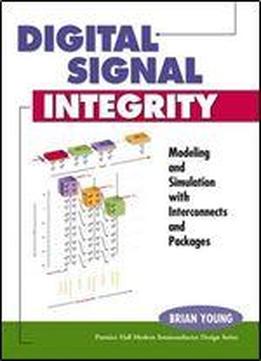
Digital Signal Integrity: Modeling And Simulation With Interconnects And Packages
by Brian Young /
2001 / English / PDF
16.7 MB Download
Preface Effects of interconnects on the electrical performance of digital components, such as microprocessors, have historically been small enough to handle with simple rules of thumb. As clock rates, bus widths, and bus speeds have increased, packaging and interconnects have more importance and in some cases actually limit or define the system, where silicon performance is usually found to be the gating factor. This role reversal will become more common, and it may be that packaging and interconnects dominate electrical considerations at some point in the future as networks become more prominent. The relatively recent growth of packaging and interconnects as significant issues in electrical performance means that relatively few resources exist for learning and training. Much of it exists as scattered applications notes, many of which are quite useful but are sometimes somewhat dated (i.e., notes on ECL rather than CMOS) or are from the less accessible technical literature. Since many organizations are newly finding the need for expertise in the field, in-house experts may not be available to act as mentors. This book represents my efforts at collecting and deriving the necessary material to support a career in digital signal integrity modeling and simulation. A huge part of such a job is package and interconnect modeling from electromagnetic simulation and/or measurements. By necessity, the book spans a broad spectrum of techniques, including electromagnetic simulation, transmission line theory, frequency-domain modeling, time-domain modeling, analog circuit simulation, digital signaling, and some architectural issues, to put it all in perspective. Such a broad technological reach makes for a very interesting and challenging job. Since I believe that the number of engineers working this area will need to increase dramatically to support the technological trends, I hope that this book will provide a sufficient set of tools to help engineers succeed in this field. The goal of the book is to provide detailed introductory material that is self-consistent and self-contained. As such, there are very few references. There is nothing in the book that is new to the field, so technical credit must go to the innumerable contributors to the technical literature, application notes, and standards. The book is organized to move gradually from broad, general topics to specific modeling techniques. Particular emphasis is placed on rigorous derivation and on multiconductor interconnects. Chapter discusses the role of signal integrity in digital systems. Chapters and then cover issues in signaling and signal integrity. Chapters through cover detailed concepts in basic passive circuit components, with particular emphasis on multiconductor interconnects. One of the more difficult aspects of detailed simulations in signal integrity is the need to model multiconductor interconnects such as sockets, packages, edge connectors, and buses. Experimental characterization of interconnects is covered in chapter, where emphasis is on measurements of very small parasitics for high leadcount interconnects. Interconnect modeling is covered in chapters and, where distinction is drawn between low-frequency lumped modeling and high-frequency wideband modeling. Because interconnects are often physically small, lumped modeling is often the optimal choice. Finally, chapter provides extended coverage of signal integrity topics and represents advanced application of material and concepts from prior chapters. The manuscript was typeset using running under Linux on a PC clone based on a Tyan motherboard with a Cyrix processor. The text was prepared using a custom text editor written in Tcl/Tk. Circuit simulations used Berkeley SPICE 3f4. The figures were prepared using Xfig. Symbolic manipulation usedMathematica. Brian Young Austin, Texas











